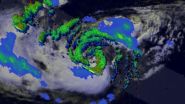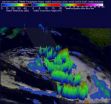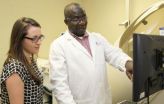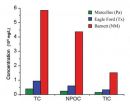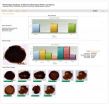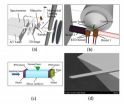(Press-News.org) VIDEO:
TRMM satellite passed over Cristobal on Aug. 27 at 8:16 a.m. EDT. Cristobal didn't appear round and symmetric in either clouds or rainfall which suggests that the hurricane is being...
Click here for more information.
NASA's Tropical Rainfall Measuring Mission or TRMM Satellite provided a look under the hood of Hurricane Cristobal as it continues moving north and paralleling the U.S. East Coast. NASA's HS3 hurricane mission also investigated the storm. Cristobal is now close enough to the coast to trigger high surf advisories.
On August 28, the National Weather Service issued an advisory for high surf of 6 to 12 feet and rip currents on the southern coasts of Rhode Island and Massachusetts, including Cape Cod and the nearby islands of Martha's Vineyard and Nantucket.
Cristobal, still a minimal Category 1 hurricane on the U.S. Saffir-Simpson scale, has been slowly making its way northward up from the southeastern Bahamas on a track generally parallel to the eastern seaboard. The storm now appears poised to recurve away from the U.S. East Coast and head for the central Atlantic as it begins to feel the effects of an approaching shortwave trough (elongated area of low pressure) embedded in the westerlies (winds) that are moving eastward out of the Great Lakes Region.
NASA's airborne Hurricane and Severe Storm Sentinel, or HS3, mission kicked off on August 27 when one of the remotely piloted Global Hawk aircraft flew a "lawnmower" or back and forth pattern over Hurricane Cristobal while gathering data using dropsondes and two other instruments. The Global Hawk dropped 81 dropsondes over Cristobal. A dropsonde is a device that measures winds, temperature, pressure and humidity as it falls from the aircraft to the surface.
The TRMM satellite passed over Hurricane Cristobal on August 27 at 12:16 UTC (8:16 a.m. EDT). TRMM is a joint mission between NASA and the Japanese space agency JAXA.
At the time TRMM flew overhead, Cristobal's center was located about 330 miles (531 km) southeast of Cape Hatteras, North Carolina and approximately 420 miles (675.9 km) west-southwest of Bermuda. At this time, an eye was still apparent in TRMM's infrared imagery, but the rain intensities from TRMM showed that there is only a partial eyewall, which is indicated by the band of moderate intensity rain along the northern edge of the storm's center. Several long rainbands of mostly light to moderate rain wrapped mainly around the eastern side of the storm and are evidence of the storm's large cyclonic circulation.
Those rainbands are very well defined in a 3-D image of Cristobal (taken at the same time) that was created at NASA's Goddard Space Flight Center in Greenbelt, Maryland. The 3-D image showed the height of precipitation echoes within the storm courtesy of the TRMM Precipitation Radar instrument. Cristobal didn't appear round and symmetric in either clouds or rainfall which suggests that the hurricane is being battered by southwesterly wind shear ahead of the approaching shortwave trough (elongated area) of low pressure. The National Hurricane Center (NHC) expects that the trough should begin to steer the storm in a more northeasterly direction. At the time of this image, Cristobal's sustained winds were reported at 70 knots (80.5 mph/129.6 kph) and the storm was still moving north at 12 mph (19.3 kph).
By August 28 at 8 a.m. EDT (1200 UTC) the center of Hurricane Cristobal was located near latitude 36.3 north and longitude 67.0 west. Maximum sustained winds remain near 75 mph (120 kph) and no significant change in strength is forecast during the next two days.
Cristobal was moving toward the northeast near 26 mph (43 kph) and that general motion with an increase in forward speed is expected over the next 48 hours. On the forecast track, the NHC noted that the center of Cristobal will rapidly move toward the North Atlantic well northwest of Bermuda and pass well south of Nova Scotia later in the day today, August 28.
With the system now devoid of heavy rain and approaching cooler waters, Cristobal should start to lose its tropical characteristics and transition into an extra-tropical storm over the next few days. The NHC expects Cristobal to become a powerful extra-tropical cyclone over the North Atlantic by Friday night, August 29.
INFORMATION:
NASA's TRMM analyzes Hurricane Cristobal
2014-08-28
ELSE PRESS RELEASES FROM THIS DATE:
A new, tunable device for spintronics
2014-08-28
Spin-charge converters are important devices in spintronics, an electronic which is not only based on the charge of electrons but also on their spin and the spin-related magnetism. Spin-charge converters enable the transformation of electric into magnetic signals and vice versa. Recently, the research group of Professor Jairo Sinova from the Institute of Physics at Johannes Gutenberg University Mainz in collaboration with researchers from the UK, Prague, and Japan, has for the first time realised a new, efficient spin-charge converter based on the common semiconductor material ...
New analysis of old HIV vaccines finds potentially protective immune response
2014-08-28
DURHAM, N.C. – Applying the benefit of hindsight, researchers at Duke Medicine have reanalyzed the findings of two historic pediatric HIV vaccine trials with encouraging results. The vaccines had in fact triggered an antibody response -- now known to be associated with protection in adults -- that was previously unrecognized in the infants studied in the 1990s.
Reporting online Aug. 28, 2014, in the Journal of Infectious Diseases, the Duke researchers relied on fresh insights that have been gleaned from a recent adult HIV vaccine trial in which the vaccine reduced the ...
New tool aids stem cell engineering for medical research
2014-08-28
ROCHESTER, Minn. — A Mayo Clinic researcher and his collaborators have developed an online analytic tool that will speed up and enhance the process of re-engineering cells for biomedical investigation. CellNet is a free-use Internet platform that uses network biology methods to aid stem cell engineering. Details of CellNet and its application to stem cell engineering are described in two back-to-back papers in the journal Cell.
"This free platform has a broad range of uses for all types of cell-based investigations and can potentially offer help to people working on all ...
UMN researchers find animal model for understudied type of muscular dystrophy
2014-08-28
MINNEAPOLIS/ST. PAUL (August 28, 2014) – Researchers at the University of Minnesota have developed an animal research model for facioscapulohumeral muscular dystrophy (FSHD) to be used for muscle regeneration research as well as studies of the effectiveness of potential therapies for FSHD.
The research is published in the current edition of the journal Cell Reports.
There is no treatment for FSHD, which is thought by many to be the most common type of muscular dystrophy. FSHD is an unusual genetic disorder because, unlike most genetic diseases, it is not caused by the ...
Breastfeeding study shows need for effective peer counseling programs
2014-08-28
Athens, Ga. – The support of peer groups and clinicians is critical to the development of effective breastfeeding programs, according to recent University of Georgia research.
A qualitative study of 21 mothers in the Athens-Clarke County area determined that role models for successful breastfeeding help positively shape the outcomes of mothers of infants.
"Mothers who received that support are more likely to be successful at breastfeeding," said study co-author Alex Anderson, an associate professor in the College of Family and Consumer Sciences department of foods and ...
New solutions needed to recycle fracking water
2014-08-28
HOUSTON – (Aug. 28, 2014) – Rice University scientists have produced a detailed analysis of water produced by hydraulic fracturing (aka fracking) of three gas reservoirs and suggested environmentally friendly remedies are needed to treat and reuse it.
More advanced recycling rather than disposal of "produced" water pumped back out of wells could calm fears of accidental spillage and save millions of gallons of fresh water a year, said Rice chemist Andrew Barron, who led the study that appeared this week in the Royal Society of Chemistry journal Environmental Science: ...
Females ignored in basic medical research
2014-08-28
CHICAGO --- A new study from Northwestern Medicine® has found that surgical researchers rarely use female animals or female cells in their published studies -- despite a huge body of evidence showing that sex differences can play a crucial role in medical research.
Editors of the five major surgical journals reviewed in this study have responded to this finding and will now require authors to state the sex of animals and cells used in their studies. If they use only one sex in their studies, they will be asked to justify why.
"Women make up half the population, but ...
UTHealth researchers find up to 3,000 times the bacterial growth on hollow-head toothbrushes
2014-08-28
HOUSTON – (Aug. 28, 2014) — Solid-head power toothbrushes retain less bacteria compared to hollow-head toothbrushes, according to researchers at The University of Texas Health Science Center at Houston (UTHealth) School of Dentistry.
The results of the study are published in the August issue of the Journal of Dental Hygiene. Lead author and professor at the UTHealth School of Dentistry, Donna Warren Morris, R.D.H., M.Ed., notes that microbial counts were lower in the solid-head toothbrush group than in the two hollow-head toothbrush groups in 9 out of 10 comparisons.
"Toothbrushes ...
Together, humans and computers can figure out the plant world
2014-08-28
As technology advances, science has become increasingly about data—how to gather it, organize it, and analyze it. The creation of key databases to analyze and share data lies at the heart of bioinformatics, or the collection, classification, storage, and analysis of biochemical and biological information using computers and software. The tools and methods used in bioinformatics have been instrumental in the development of fields such as molecular genetics and genomics. But, in the plant sciences, bioinformatics and biometrics are employed in all fields—not just genomics—to ...
New analytical technology reveals 'nanomechanical' surface traits
2014-08-28
WEST LAFAYETTE, Ind. – A new research platform uses a laser to measure the "nanomechanical" properties of tiny structures undergoing stress and heating, an approach likely to yield insights to improve designs for microelectronics and batteries.
This new technique, called nanomechanical Raman spectroscopy, reveals information about how heating and the surface stress of microscale structures affect their mechanical properties. Researchers have discussed the merits of surface-stress influence on mechanical properties for decades. However, the nanomechanical Raman spectroscopy ...

